Camp – Alternative sensuality Кэмп – альтернативная чувственность Куратор: Даша Бирюкова (ГЦСИ) 20-22 ноября, Музей Москвы В рамках фестиваля Plums Fest 6
Участники:
1.
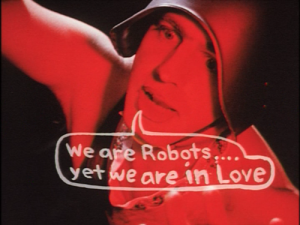
Майк Кучар. Грехи роботов воплоти. 1965. Фильм. 43’
«Грехи роботов воплоти» – андерграундный фильм 1965 года режиссера Майка Кучара. Это малобюджетный фильм в стилистики кэмп сай-фай про восстание роботов в будущем, через миллион лет, когда люди стали слишком ленивы и эгоистичны, чтобы заботиться о себе самим. Именно этот фильм оказал сильное влияние на культового режиссера Джона Уотерса, который является одной из главных фигур в кэмп-кинематографе. Миллион лет в будущем, люди создали расу человекоподобных роботов под названием Fleshapoids, которые выполняли все их желания. В результате, люди стали эгоистичными и ленивыми, так как у них больше не было нужды работать или делать что-либо, чтобы заботиться о себе. Однажды, робот по имени Ксар (Боб Коуэн) восстает против рабского существования и убивает свою госпожу (Джина Цукерман). Он воссоединяется с женским роботом по имени Меленка (Марен Томас), которая обслуживает Принца Джанбено (Джордж Кучар) и принцесуа Вивианну (Донна Кернесс). В то время как Ксар и Меленка в тайне влюбляются друг в друга, брак между принцем и принцессой разваливается. Пока принцесса пытается обмануть своего мужа и сбежать с любовником Эрни (Джулиус Миддлмен), принц раскрывает незаконный роман роботов и пытается остановить их. Но Ксар снова теряет самообладание и вместе с Меленкой убивают принца. Но со смертью рождается новая жизнь, так как необычный акт любви между Ксаром и Меленкой дает жизнь милому роботу ребенку.
Mike Kuchar. Sins of the Fleshapoids. 1965. Film. 43’
Sins of the Fleshapoids is a 1965 underground film directed by Mike Kuchar. It is a low-budget, campy sci-fi movie about an android revolt a million years in the future after humans have become too lazy and selfish to take care of themselves. The film was a major influence on cult director John Waters who has said that Sins of the Fleshapoids “really shows what an underground movie was. One million years in the future, human beings have created a race of human-looking androids called Fleshapoids to fulfill their every desire. As a result, humans have become selfish and lazy as they no longer need to work or do anything to take care of themselves. One day, a Fleshapoid named Xar (Bob Cowan) revolts, kills his female human master (Gina Zuckerman) and hooks up with a female Fleshapoid named Melenka (Maren Thomas), who services Prince Gianbeno (George Kuchar) and Princess Vivianna (Donna Kerness). While Xar and Melenka fall in love in secret, the marriage between the Prince and Princess is falling apart. As the Princess tries to deceive her husband and run away with her lover, Ernie (Julius Middleman), the Prince uncovers the Fleshapoids’ illicit romance and attempts to stop them. But Xar flips out again and he and Melenka kill the Prince. But, with death also comes life, as Xar and Melenka’s unusual lovemaking produces a cute baby robot.
2.
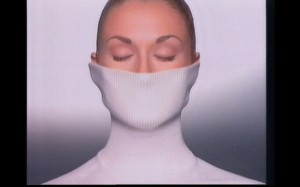
Дэниел Пфлюмм. Без названия. 2000. 4х-канальная видео инсталляция. 29’, loop.
Дэниел Пфлюмм (1968) живет и работает в Берлине (Германия).
Дэниел Пфлюмм – видео и медиа художник, основатель клуба «Электро» в Берлине в начале 1990х годов. Художник работает с логотипами и товарными знаками транснациональных компаний, которые он сводит к абстрактным образам и персонажам. Параллельно он разрабатывает свои собственные логотипы и фирменные стили. Он создает графику, макеты и мерчендайзинг для компаний, которые не существуют, как вымышленные стратегии компании в контексте искусства. «Гладкая» эстетика его визуальных конструкций измеряется по меркам современных рекламных стратегий и маркетинга продукции. Она приближается к ожиданиям современной рекламной эстетики и в конечном итоге извращает ее изнутри. Работы Пфлюмма увлекают своей неоднозначной элегантностью, проецируя пустое сообщение, рекламируя ничто, критикуя снова и снова консюмеризм капиталистического мира. Видео инсталляция «Без названия» 2000 года представляет собой зацикленные видео, выполненные по образу рекламных роликов, которые несут в себе абстрактные стереотипные представления о продуктах потребления. Минималистские петли повторяющихся видео изображений становятся основным мотивом мирового обращения товаров, циркуляции желания в мире избыточного потребления.
Daniel Pflumm. Untitled. 2000 4-channel video installation. 29 ‘, loop.
Daniel Pflumm (1968) lives and works in Berlin (Germany).
Daniel Pflyumm – video and media artist, founder of the club «Electro» in Berlin in the early 1990s. The artist works with the logos and trademarks of multinational companies, which he brings to the abstract images and characters. In parallel, it develops its own logo and corporate identity. He creates graphics, layouts and merchandising for companies that do not exist, as the fictional company’s strategy in the context of art. The «polished» aesthetics of his visual structures measured by the standards of modern advertising strategies and marketing products. It is close to the expectations of the modern aesthetics of advertising and ultimately corrupts her from itself. Pflumm’s works captivate its ambiguous elegance, projecting a empty message, advertising of nothing, criticizing again consumerism of the capitalist world. Video installation “Untitled” 2000 is a looped video, made in the image of commercials that carry abstract stereotypes about consumer products. Minimalist repetitive loop video images are the main motive of the global circulation of products, the circulation of desire in the world of excessive consumption.
3.
![pirmin]](http://plumsfest.ru/wp-content/uploads/2014/11/pirmin-300x98.jpg)
Пирмин Блум. Напоминание о Смерти в Медиуме. 2014. Зацикленное видео, без звука.
Пирмин Блум живет и работает в Вене, Австрия.
Триумф популизма – (и популизм всегда сводится к популизму) – собирается ли он завоевать реальность сопротивления? В этом мой вопрос. Кэмп или «иная чувственность» может рассматриваться как программная стратегия для белого куба, своего рода коллективный арт-лагерь 20-го и начала 21-го века, с его традициями как «поп-концепций» 1960-х, так и 90-х годов, которая в конечном итоге сводятся к понятиям пост-изм и «тарифу контркультуры» (термин Пирмина Блума) – начиная с так называемых изобретенных «финансовых кризисов после 9/11». Факт в том, что «реализм» неверно употреблялся в 20 веке тоталитарными системами, например, нацистами по отношению к коммунистическим системам, таким, как Северная Корея, где «социалистический реализм» работал на прославление державы и использовался в качестве инструмента пропаганды. После 9/11 наступила так называемая «война образов/изображений», и видео «Напоминание о Смерти в Медиуме» основано на выявлении глубокой и комплексной структуры фашизма в субкультуре самого медиа.
Pirmin Blum. Recall to Death in a Medium. 2014. Endless (Projection)
Pirmin Blum lives and works in Vienna, Austria.
This video work represents a close-up of an odd process of shooting / killing a mobile devise in a slow motion. Being a found footage from YouTube it might be seen as a straightforward illustration of the “war of images” that has changed both the media space and the space of actual military conflicts sourced out from the very space that is being discussed in it, namely the media. However this poignant critique of the power of media and new technologies as a new weapon unfolds in the atmosphere reminiscent of American western movies, allocating the past and the present on the same plain. At the same time unlike western stories where there is always a hero or an antihero in this video the person carrying out the action is left behind the scenes, pushed out of the process triggered by him/her. Without a human being in the frame of the video we face the technology versus technology conflict, that might be considered as an endpoint of technology, but a new start for reconsidering humanity.
Splinters of a screen glass flying apart create for the viewer a shimmering mesmerizing effect that reconciles the video with MTV aesthetics. In so doing the video itself intensifies the mechanism it’s supposed to uncover – when serious narrative is overshadowed by the glory of the image. And this approach is doubled by the infinite resurrection of the mobile phone, created with the help of endless repetition effect.
4.
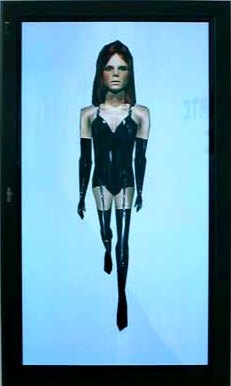
Тобиас Бернструп. Ходячее эго. 2003. Закольцованное видео.
Тобиас Бернструп родился в 1970 оду в Гетеборге, Швеция.
В работе «Ходячее эго» мы видим цифровой аватар Бернструпа в костюме робота с женской грудью, безостановочно идущего по направлению к зрителю. Анимация представляет собой модификацию известной видеоигры Half-Life 2 и использует ее инструменты для создания новых персонажей – в данном случае аватара с лицом художника, одетого в костюм, используемый в перформансах. Уже много лет музыкальные перформансы и анимация Бернструпа, задействуя приемы травести и меланхолическую синтезаторную музыку, затрагивают вопросы гендера, сексуальности, реальности, фантазии, производства желания и сексуальной фетишизации иллюзий. «Ходячее эго» является продолжением ранних работ художника. Тело на экране еще больше отдалилось от четких гендерных категорий. Перформансы Бернструпа достигли более абстрактной, символической стадии и перешли от вопросов трансгендерности и «реальной» жизни к более фантазийным, гибридным смыслам. Текст: Йеспер Нордаль
Tobias Bernstrup. Walking Ego, 2003. Video, DVD. Endless loop.
Tobias Bernstrup was born 1970 Gothenburg, Sweden.
In ‘Walking Ego’, we see Bernstrup’s digital alter ego, dressed in a robotic costume, with breasts, walking endlessly towards the viewer. The animation is made by modifying the famous video game Half-Life2 and using its tools for character animation in order to create an avatar textured with the artist’s face and performance outfit. Bernstrup’s musical performances and animations have since many years addressed issues on gender, sexuality, reality, fiction, the production of desire and the sexual fetishisation of dreams through drag and melancholic synth-disco. ‘Walking Ego’ extends the artist’s previous work as the body that appears has further transformed away from clear gender categories and become more queer. Bernstrup’s art/drag performances have also reached a more abstracted, symbolic stage, and drifted away from addressing trans-gender and ‘real’ life to more fictive, hybrid references. Text by Jesper Nordahl
5.
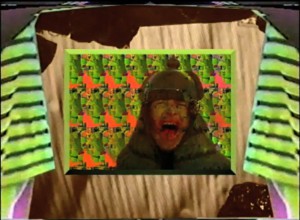
Люк Вайт. Sad Stonewash: 2011. A Video Mulch (Видео мусор). 40’
Лук Вайт живет и работает в Бруклине (Нью-Йорк, США) и Берлине (Германия).
Sad Stonewash: 2011. A Video Mulch (Видео мусор). 40’ «Я выбираю видео, в которых присутствует настроение резонанса или композиционная энергия. Мой видеомагнитофон получает встряску доксайдером 13 размера, пока не начинает делать ошибки, и VHS лента «выворачивает» саму себя. В то время как оцифровывается видео, я заставляю компьютер делать ошибки, не говоря ему правду о данных, которые он поглощает. Я отбираю ошибки, которые мне больше всего нравится, отмечаю их и отправляю обратно в мой видеомагнитофон, возобновляю атаку доксайдерами, повторяя этот процесс, пока не достигну эффекта «анти-блеска», теряя чёткость изображения, как если бы они всегда существовали в таком виде. Затем я структурирую изображения в таком порядке, в каком они должны идти. Я называю результат этого метода – видео мусор. Для этой работы, видео ряд уже был у меня в голове: вялая костюмная печаль с оттенком мучительных закатов Майкла Манна. Холодная погода – кузен печали: суровая, серая, готическая грусть от нескольких старых групп, которые играли на звенящих с задержкой гитарах. Шестиуровневая одержимость (мечта о небе), встреча совершеннолетнего ботинка и ноги любви (зависание земли). Обе короны и замки указывают на небо (или пространство), башенки и минареты указывают, куда должны стрелять цари. Помните, как замок Волтрона стал космическим кораблем и поднялся с земли?»
Luke Wyatt. Sad Stonewash: 2011. A Video Mulch. 40’
Luke Wyatt lives and works in Brooklyn, NY and Berlin, Germany.
«I collect and reframe imagery that reminds me of 9th grade instincts to soundtrack my Saturday detention: the towers, moats. swords, sideways glances from dark-haired girls and fingerless glove pumps from misunderstood boys. Aware of the generationally solipsisic dead-end of nostalgia, I also stay open for stuff that startles me from a fresh direction but till reinforces my through-line of obsessions. So I make video to protect my world. Read about my audio armor below. The vagaries of old VHS tape helped Luke flesh out a longstanding obsession with elevating decay and the thrown-away. These explorations manifest live as performance using a stack of old VCRs, a video mixer, and push-ups. Edits appear as long form pieces or short form accompaniment to the work of a select group of musical artists». Sad Stonewash: 2011. A Video Mulch. 40’ “I select video to appropriate based on its mood resonance or compositional zing. My VCR gets beat up with a size 13 docksider until it makes errors and the VHS tape spits up on itself. While digitizing the video I induce the computer to make mistakes by not telling it the truth about the data it is ingesting. I isolate the mistakes I like best, outline them, and send them back to my VCR, resuming the docksider attack, repeating this process until things attain an anti-sheen, losing any crisp edge, as if they had always belonged together. I then arrange the images in an order that must appear equally inevitable. I term the results of this technique Video Mulch. For this work, the following was on my mind: languid linen-suit sadness via the stylish poignancy of Michael Mann sunsets. A cold weather cousin sadness to that: the dour, grey, gothic sadness of a few old bands who played chiming delay guitar. Sixth grade sword obsessions (a dream of the sky), meet adult shoe and leg love (hangups of the earth). Both crowns and castles point to the sky (or space), pinnacles and minarets announcing heaven as the place kings should shoot for. Remember how the Voltron castle became a spaceship and lifted off the earth?”
6.
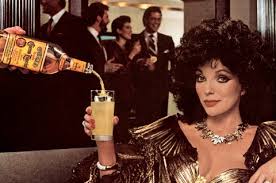
SmashTV (Брендон Шилдз и Бэн Кроу). Memorex. 2013. Video, DVD. 50’
SmashTV (Брендон Шилдз и Бэн Кроу) – группа видео художников, живут и работают в Бруклине (Нью-Йорк, США). Группа Smash TV работает с SuperCut и коллажированием культур, которые процветали на протяжении 2000-х годов, когда профессиональное программное обеспечение для редактирования видео стало доступно для широких масс. Youtube и Vimeo стали платформами, где можно легко делиться давно забытыми видеоматериалами, встраивая их в контекст современной культуры. Цель Smash TV в том, чтобы делать цельные продолжительные VJ миксы, основанные на ностальгических кадрах из детства. Используя эстетику MTV 1980х годов, Smash TV создают атмосферу смутного воспоминания о детстве, проведенного у телевизора, сочетая электронную ретро музыку с гипер яркой и смонтированной графикой.
MEMOREX. «Сиквел группы SmashTV «Skinemax»«Memorex» – это 50ти минутная VJ одиссея, дань целому поколению, выросшему на ТВ и видеомагнитофонах для бебиситтеров. Основанное на более чем сорока часах коммерческих фильмов 80-х годов, реинкарнированных из скрученных VHS пленок, видео «Memorex» – это основательное исследование ностальгии и культурных ценностей в эпоху избытка. Это реконтекстуализация рекламы – культурных осколков, самого низкого из низкого жанра, что вместе рождает нечто более глубокое, иронистическое, а порой, даже прекрасное. Звук идеально сочетается с ностальгическими и порой извращенными кадрами. Ощущение будто нашел свои любимые видео кассеты, пролежавшие под солнцем лет 25. «Memorex» – это аудио-визуальное произведение, смонтированное так, чтобы складывалось ощущение аутентичного происхождения. Окончательная версия видео была записана на VHS. Это жизнь или это Memorex?» Видео «Memorex» было названо в честь самой большой компании электроники в Америке в 80-е годы, которая специализируется на аудио- и видеокассетах. Также название является сочетанием слов «memory» (память) и «rex» (в переводе с латинского – король) – Король Памяти, отсылающий к теме ностальгии.
SmashTV (Brendan Shields and Ben Craw). Memorex. 2013. Video, DVD. 50’
Smash TV was born out of the supercut and mashup cultures which flourished throughout the 2000s as professional editing software became available to the masses. With Youtube and Vimeo providing platforms to easily share long forgotten video footage, re-contextualized video art soon became abundant. Smash TV’s goal is to make cohesive longform VJ mixes using nostalgic footage from our childhood. Borrowing heavily from the hypercolor “in your face” aesthetic of 80s MTV, Smash TV is a vague memory of a childhood spent glued to the television, combining retro electronic music with hyper editing and bright visuals. Smash TV is comprised of Brendan Shields and Ben Craw and based in Brooklyn, New York. https://vimeo.com/supersmashtv
MEMOREX The sequel to Smash TV’s “Skinemax”, Memorex is a 50 minute VJ odyssey, a tribute to an entire generation who grew up with only a TV and a VCR for a babysitter. Sourced from over forty hours of 80s commercials pulled from warped VHS tapes, Memorex is a deep exploration of nostalgia and the cultural values of an era of excess. It’s a re-contextualization of ads – cultural detritus, the lowest of the low – into something altogether more profound, humorous, and at times, even beautiful. The audio provides a perfect accompaniment to the warped and weirdly nostalgic footage, like finding your favorite cassette from childhood after it’s been baking in the sun for 25 years. An authentic audio/visual package, Memorex was designed to look and feel like the real deal. The ultimate VHS tape. Is it live, or is it Memorex? Memorex was named after the electronics company which was big in America in the 80s. They specialized in audio and video cassettes. It also a combination of the words memory and “rex” which is Latin for king. So King of Memory basically, which I liked given the nostalgic theme.
7.
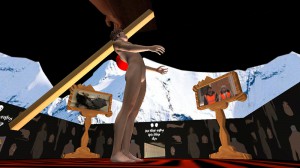
Дмитрий Кавко. Mama-Game. 2013. Interactive computer game
Дмитрий Кавко живет и работает в Москве (Россия).
Mama-Game – компьютерная игра / виртуальная галерея, в которой представлены цифровые скульптуры художника. Пространство галереи позволяет с разных сторон осматривать экспонаты выставки, находиться с рядом ними и чувствовать их масштаб. У игры нет сюжета и цели в традиционном смысле. В ней присутствуют лишь созерцание и впечатление. Представленные объекты не несут в себе конкретных интерпретаций, а скорее создают атмосферу ужаса и отвращения. Не на уровне сюжета, а на уровне чувств, на уровне памяти и опыта. Художник строит убедительный мир, реальный и нереальный одновременно. Неприятные ощущения заложены даже в пустоту, в пространство, не заполненное объектами и образами. Надписи на стенах намеренно бессодержательные, чтобы зритель не отвлекался на конкретные сообщения. Хотя конкретные содержательные образы там присутствуют, и в большом количестве, но что они означают, сознательно не объясняется. Здесь важна интерпретация зрителя. Mama Game – это безграничное виртуальное пространство ужаса. Пространство, где нет ни времени, ни верха, ни низа. Там можно смоделировать любую жизнь, и там нет смерти. Хотя, возможно, именно там она и живёт. Музыка Ромы Литвинова (Mujuice).
Dmitriy Kavko. Mama-Game. 2013. Interactive computer game
Dmitriy Kavko lives and works in Moscow (Russia).
Mama-Game – a computer game / virtual gallery, which presents digital sculptures of the artist. Gallery space allows different parties viewing the exhibits, to be near them and feel their scale. The game has no plot and purpose in the traditional sense. It contains only the contemplation and experience. Representation of the object does not carry a specific interpretations, but rather create an atmosphere of horror and disgust. Not at the scene, but at the level of feelings, memory and level of experience. Artist builds a convincing world, real and unreal at the same time. Discomfort even incorporated into the void, into the space not filled with objects and images. Graffiti deliberately meaningless to the viewer is not distracted by concrete messages. Although the specific content images are present there, and lots of it, but what they mean, deliberately not explained. Here is an important interpretation of the viewer. Mama Game – it’s unlimited virtual space of horror. Space where there is no time, no top or bottom. There can simulate any life, and there is no death. Though perhaps that is where she lives. Music Roma Litvinov (Mujuice).
8.

Протей Темен. The Passion: Video Part. 2011. Видео. 7’
Протей Темен живет и работает в Москве (Россия).
The Passion: Video Part – видео-версия анимационного фильма о соединении человека с его миром грез, исследовании возможностей изменить мир вокруг себя и насильственному вторжению в чужой символический ряд. Фильм снят при поддержке фестиваля Rojo Nova, в Сан-Пауло, Бразилия
Protey Temen. The Passion: Video Part. 2011-2014. Video. 20’
Protey Temen lives and works in Moscow, Russia.
The Passion: Video Part – video version of the animated film about the connection of man with his world of dreams, study of opportunities how to change the world around them and forced entry into someone else’s symbolic world.
9.
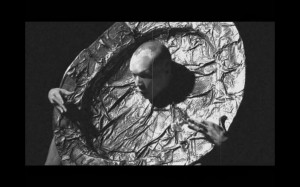
Poema театр. Слезы спящего андрогина (Black Sun Productions, Валентин Цзин, Лаборатория изящных искусств). 2011. Видео. 6’24’’.
Видео – Евгения Четверткова
«Эй! Подождите!!! Мы еще не закончили с оркестром. Нам все еще надо закончить представление. Мы оставили много открытых кавычек там, где прожекторы ослепляют глаза и иголки сцены жгут нашу кожу. Было уже в воздухе здесь; возможно, мы должны прийти суда еще раз. Мы должны побеспокоить спящего андрогина еще один раз и внимательно прочитать его сонные глаза. Эти ветры – это ветры из его приоткрытых глаз – это поэтика. Глаза полные слез. Зеленые слезы и потная кожа. Их авторы удовлетворены тем, что их андрогин еще не проснулся. Вся его поэзия в его диком пробуждении… Разве мы когда-нибудь видели нечто подобное раньше? И должны ли мы оставить колючую ель на сцене? И должны ли мы сюда вообще прийти? И должны ли мы вращаться вокруг себя?… Этот мини-фильм сделан из отголосков нашей глубинной памяти, ключ от которой был дан нам Массимо и Пирома, основателям группы Black Sun Productions. В клипе использованы композиции «Cat serenade» и «Veneration XXX». Poema театр
Poema theatre. The tears of a sleeping androgyne (Black Sun Productions, Valentin Tszin, Laboratory of Fine Arts). 2011. Video. 6’24’’.
Video – Evgenia Chetvertkova
«Hey! Wait!!! We’re still not out of the orchestra. We still have to finish the performance. We have left a lot of promised quotes over there, where there are the flashlights blinding the eyes and the needles of the stage platform are burning our skin. It has been already aired here; perhaps we should come there once again. We should disturb the sleeping androgyne once again and attentively read his sleepy eyes. Those winds are the winds from his eyes just opening – they are poetic. They are wet through with tears. Green tears and sweaty skin. Their authors are satisfied that their androgyne has not awakened yet. All his poetry is in his wild awakenessless… Have we ever seen this before? And should we leave the spiny fir-tree of the stage? Should we come here at all? And should we spin around ourselves?… This mini-movie is made out of the echoes of our deep memory, the key to which has been given to us by Massimo and Pierce, the founders of the group Black Sun Productions. In the clip there are featured compositions «Cat serenade» and «Veneration XXX». Poema theatre


